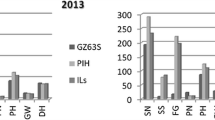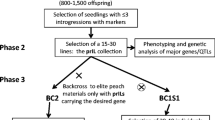Abstract
A series of introgression lines (ILs) were generated from repeated backcrossing between the exotic hexaploid wheat genotype Am3 and the common wheat genotype Laizhou953. Am3 was synthesized by crossing Triticum carthlicum with Aegilops tauschii and was used as the donor parent in this study, and Laizhou953 was used as the recurrent parent. Two hundred and five SSR markers showing polymorphism between the two parents were used to identify the introgressed Am3 chromosome segments in 97 BC4F3 ILs. The introgressed segments in each line and the length of the introgressed segments were estimated according to the wheat SSR consensus map. The introgressed segments from Am3 in the 97 lines covers 37.7% of the donor genome. The introgressed segments were most found on 2D, 3B, 6B, and 1D with coverage of 59.8, 59.5, 59.1, and 59% of the chromosomes, respectively. None of the 97 lines tested contained chromosome 4D segments introgressed from Am3. Introgressed segments for each of the chromosomes were mapped using the consensus wheat linkage map. Nine agronomic traits from BC4F3 lines were evaluated and the phenotype showed most lines have the tendency to be more similar to the recurrent parent. There were lines showing better agronomic traits than the recurrent parent, which indicated the introgression of favorable alleles from the exotic hexaploid wheat into the elite cultivar Laizhou953. Marker and phenotype data were used to identify quantitative trait loci (QTLs) controlling these nine traits. In total, 38, 33, and 28 putative QTLs were detected for seven of the nine traits in 2003, 2004, and 2005, respectively. Some of these agronomic important QTLs were detected in more than one season.





Similar content being viewed by others
References
Alpert KB, Tanksley SD (1996) High-resolution mapping and isolation of a yeast artificial chromosome contig containing fw2.2: a major fruit weight quantitative trait locus in tomato. Proc Nat Acad Sci USA 93:15503–25507
Ashikari M, Sakakibara H, Lin S, Yamamoto T, Takashi T, Nishimura A, Angeles ER, Qian Q, Kitano H, Matsuoka M (2005) Cytokinin oxidase regulates rice grain production. Science. DOI 10.1126/science.1113373
Bernacchi D, Beck-Bunn D, Emmatty D, Eshed T, Inai S, Lopez Y, Petiard V, Sayama H, Uhlig J, Zamir D, Tanksley SD (1998) Advanced backcross QTL analysis of tomato. II. Evaluation of near isogenic lines carrying single-donor introgressions for desirable wild QTL-alleles derived from Lycopersicon hirsutum and L. pimpinellifolium. Theor Appl Genet 97:170–180
Börner A, Schumann E, Fürste A, Cöster H, Leithold B, Röder MS, Weber WE (2002) Mapping of quantitative trait loci determining agronomic important characters in hexaploid wheat (Triticum aestivum L.). Theor Appl Genet 105:921–936
Bouchez A, Hospital F, Causse M, Gallais A, Charcosset A (2002) Marker-assisted introgression of favorable alleles at quantitative trait loci between maize elite lines. Genetics 162:1945–1959
Chetelat RT, Meglic V (2000) Molecular mapping of chromosome segments introgressed from Solanum lycopersicoides into cultivated tomato (Lycopersicon esculentum). Theor Appl Genet 100:232–241
Concibido VC, Vallee BL, Mclaird P, Pineda N, Meyer J, Hummel L, Yang J, Wu K, Delannay X (2003) Introgression of a quantitative trait locus for yield from Glycine sojainto commercial soybean cultivars. Theor Appl Genet 106:575–582
Eshed Y, Zamir D (1994a) A genomic library of Lycopersicon pennellii in L. esculentum: a tool for mapping of genes. Euphytica 79:175–179
Eshed Y, Zamir D (1994b) Introgression from Lycopersicon pennellii can improve the soluble-solid yield of tomato hybrids. Theor Appl Genet 88:891–897
Eshed Y, Zamir D (1995) An introgression line population of Lycopersicon pennellii in the cultivated tomato enables the identification and fine mapping of yield-associated QTL. Genetics 141:1147–1162
Frary A, Nesbitt TC, Frary A, Grandillo S, Knaap E, Cong B, Liu J, Meller J, Elbert R, Alpert KB, Tanksley SD (2000) fw2.2: a quantitative trait locus key to the evolution of tomato fruit size. Science 289:85–88
Frey KJ, Cox TS, Rodgers DM, Cox PB (1983) Increasing cereal yields with genes from wild and weedy species. In: Proceedings of the 15th international genetics congress, New Delhi, December 12–21. Oxford and IBH Publishing Co., New Delhi, pp 51–68
Fridman E, Carrari F, Liu YS, Fernie A, Zamir D (2005) Zooming in on a quantitative trait for tomato yield using interspecific introgressions. Science 301:1786–1789
Fulton TM, Beck-Bunn T, Emmatty D, Eshed Y, Lopez J, Petiard V, Uhlig J, Zamir D, Tanksley SD (1997) QTL analysis of an advanced backcross of Lycopersicon peruvianum to the cultivated tomato and comparisons with QTLs found in other wild species. Theor Appl Genet 95:881–894
Gao LF, Jing RL, Huo NX, Li Y, Li XP, Zhou RH, Chang XP, Tang JF, Ma ZY, Jia JZ (2004) One hundred and one new microsatellite loci derived from ESTs (EST-SSR) in bread wheat. Theor Appl Genet 108:1392–1400
Gur A, Zamir D (2004) Unused natural variation can lift yield barriers in plant breeding. PLoS Biol 2:1610–1615
Hanocq E, Niarquin M, Heumez E, Rousset M, Gouis JL (2004) Detection and mapping of QTL for earliness components in a bread wheat recombinant inbred lines population. Theor Appl Genet 110:106–115
Howell PM, Marshall DF, Lydiate DJ (1996) Towards developing intervarietal substitution lines in Brassica napus using marker-assist selection. Genome 39:348–358
Huang XQ, Cöster H, Ganal MW, Röder MS (2003) Advanced backcross QTL analysis for the identification of quantitative trait loci alleles from wild relatives of wheat (Triticum aestivum L.). Theor Appl Genet 106:1379–1389
Huang XQ, Kempf H, Ganal MW, Röder MS (2004) Advanced backcross QTL analysis in progenies derived from a cross between a German elite winter wheat variety and a synthetic wheat (Triticum aestivum L.). Theor Appl Genet 109:933–943
Ishimaru K (2003) Identification of a locus increasing rice yield and physiological analysis of its function. Plant Physiol 133:1083–1090
Jeuken MJW, Lindhout P (2004) The development of lettuce backcross inbred lines (BILs) for exploitation of the Lactuca saligna (wild lettuce) germplasm. Theor Appl Genet 109:394–401
Kashiwagi T, Ishimaru K (2004) Identification and functional analysis of a locus for improvement of lodging resistance in rice. Plant Physiol 134:676–683
Khavkin E, Coe E (1997) Mapped genomic locations for developmental functions and QTLs reflect concerted groups in maize (Zea mays L.). Theor Appl Genet 95:343–352
Korff M, Wang H, Le J, Pillen K (2004) Development of candidate introgression lines using an exotic barley accession (Hordeum vulgare ssp. spontaneum) as donor. Theor Appl Genet 109:1736–1745
Lin SY, Sasaki T, Yano M (1998) Mapping quantitative trait loci controlling seed dormancy and heading date in rice, Oryza sativa L., using backcross inbred lines. Theor Appl Genet 96:997–1003
Liu J, Cong B, Tanksley SD (2003) Generation and analysis of an artificial gene dosage series in tomato to study the mechanisms by which the cloned quantitative trait locus fw2.2 controls fruit size. Plant Physiol 132:292–299
Matus L, Corey A, Filichkin T, Hayes PM, Vales MI, Kling J, Riera-Lizarazu O, Sato K, Powell W, Waugh R (2003) Development and characterization of recombinant chromosome substitution lines (RCSLs) using Hordeum vulgare subsp. Spontaneum as a source of donor alleles in a Hordeum vulgare subsp. vulgare background. Genome 46:1010–1023
Moncada P, Martinez CP, Borrero J (2001) Quantative trait loci for yield and yield component in an Oryza sativa × Oryza rufipogon BC2F2 population evaluated in an upland environment. Theor Appl Genet 102:41–52
Monforte AJ, Tanksley SD (2000) Fine mapping of a quantitative trait locus (QTL) from Lycopersicon hirsutum chromosome 1 affecting fruit characteristics and agronomic traits: breaking linkage among QTLs affecting different traits and dissection of heterosis for yield. Theor Appl Genet 100:471–479
Nesbitt TC, Tanksley SD (2001) fw2.2 directly affects the size of developing tomato fruit, with secondary effects on fruit number and photosynthate distribution. Plant Physiol 127:575–583
Paterson AH, Deverna JW, Lanini B, Tanksley SD (1990) Fine mapping of quantitative trait loci using selected overlapping recombinant chromosomes, in an interspecies cross of tomato. Genetics 124:735–742
Pestsova E, Ganal MW, Röder MS (2000) Isolation and mapping of microsatellite markers specific for the D genome of bread wheat. Genome 43:689–697
Pillen K, Zacharias A (2003) Advanced backcross QTL analysis in barley (Hordeum vulgare L.). Theor Appl Genet 107:340–352
Quarrie SA, Steed A, Calestani C, Semikhodskii A, Lebreton C, Chinoy C, Steele N, Pljevljakusic D, Waterman E, Weyen J, Schondelmaier J, Habash DZ, Farmer P, Saker L, Clarkson DT, Abugalieva A, Yessimbekova M, Turuspekov Y, Abugalieva S, Tuberosa R, Sanguineti MC, Hollington PA, Aragués R, Royo A, Dodig D (2005) A high-density genetic map of hexaploid wheat (Triticum aestivum L.) from the cross Chinese Spring × SQ1 and its use to compare QTLs for grain yield across a range of environments. Theor Appl Genet 110:865–880
Ramsay LD, Jennings DE, Bohuon EJR (1996) The construction of substitution library of recombinant backcross lines in Brassica oleracea for the precision mapping of quantative trait loci. Genome 39:558–567
Röder MS, Korzun V, Wendehake K, Plaschke J, Tixier M, Leroy P, Ganal MW (1998) A microsatellite map of wheat. Genetics 149:2007–2023
Sharp PJ, Chao S, Desai S, Gale MD (1989). The isolation, characterization and application in the Triticeae of a set of wheat RFLP probes identifying each homologous chromosome arm. Theor Appl Genet 78: 342–348
Shen L, Courtois B, McNally KL, Robin S, Li Z (2001) Evaluation of near-isogenic lines of rice introgressed with QTLs for root depth through marker-aided selection. Theor Appl Genet 103:75–83
Somers DJ, Isaac P, Edwards K (2004) A high-density microsatellite consensus map for bread wheat (Triticum aestivum L.). Theor Appl Genet 109:1105–1114
Tanksley SD, Nelson JC (1996) Advanced backcross QTL analysis: a method of the simultaneous discovery and transfer of valuable QTLs from unadapted germplasm into elite breeding lines. Theor Appl Genet 92:191–203
Tanksley SD, Grandillo S, Fulton TM, Zamir D, Eshed Y, Petiard V, Lopez J, Beck-Brunn T (1996) Advanced backcross QTL analysis in a cross between an elite processing line of tomato and its wild relative L. pimpinellifolium. Theor Appl Genet 92:213–224
Thomas WTB (2003) Prospects for molecular breeding of barley. Ann Appl Biol 142:1–12
Toojinda T, Baird A, Booth L, Broers P, Hayes P, Powell W, Thomas W, Vivar H, Young G (1998) Introgression of quantitative trait loci (QTLs) determining stripe rust resistance in barley: an example of marker-assisted line development. Theor Appl Genet 96:123–131
Toth B, Galiba G, Feher E, Sutka J, Snape JW (2003) Mapping genes affecting flowering time and frost resistance on chromosome 5B of wheat. Theor Appl Genet 107:509–514
Xiao J, Li J, Grandillo S, Ahn SN, Yuan L, Tanksley SD, McCouch SR (1998) Identification of trait-improving quantitative trait loci alleles from a wild rice relative, Oryza rufipogon. Genetics 150:899–909
Yamamoto T, Kuboki Y, Lin SY (1998) Fine mapping of quantative trait loci Hd1, Hd2 and Hd3 controlling heading date of rice, as single Mendelian factors. Theor Appl Genet 97:37–44
Yano M, Katayose Y, Ashikari M, Yamanouchi U, Monna L, Fuse T, Baba T, Yamamoto K, Umehara YY, Nagamura Y, Sasaki T (2000) Hd1, a major photoperiod sensitivity quantitative trait locus in rice, is closely related to the Arabidopsis flowering time gene CONSTANS. Plant Cell 12:2473–2483
Zamir D (2001) Improving plant breeding with exotic genetic libraries. Nat Rev Genet 2:983–989
Acknowledgements
The project was sponsored by the National Basic Research Project of China (2004CB117200). We are thankful to Dr. Chunji Liu from CSIRO, Plant Industry, Australia; Dr. Jiankang Wang from Institute of Crop Sci, CAAS, for revising this manuscript.
Author information
Authors and Affiliations
Corresponding author
Additional information
Communicated by J. W. Snape
Electronic supplementary material
Rights and permissions
About this article
Cite this article
Liu, S., Zhou, R., Dong, Y. et al. Development, utilization of introgression lines using a synthetic wheat as donor. Theor Appl Genet 112, 1360–1373 (2006). https://doi.org/10.1007/s00122-006-0238-x
Received:
Accepted:
Published:
Issue Date:
DOI: https://doi.org/10.1007/s00122-006-0238-x




